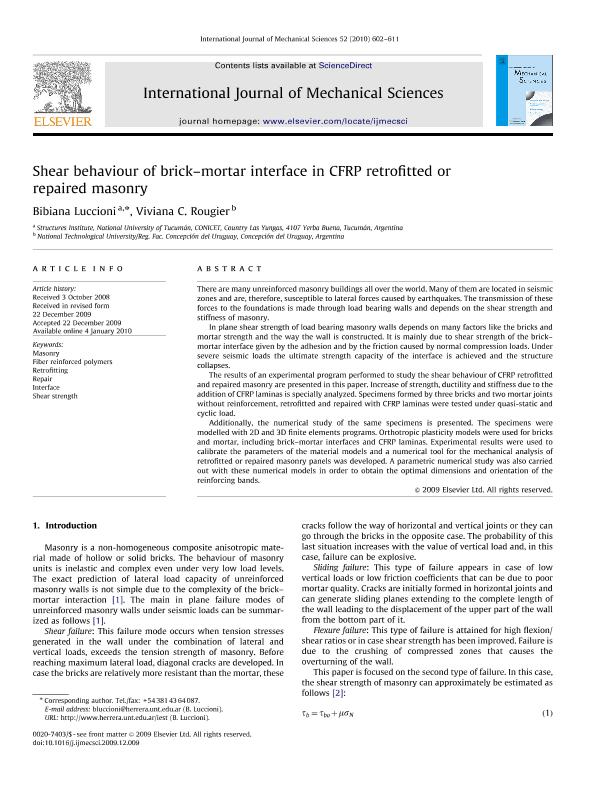Mostrar el registro sencillo del ítem
dc.contributor.author
Luccioni, Bibiana Maria

dc.contributor.author
Rougier, Viviana C.
dc.date.available
2019-03-25T18:39:34Z
dc.date.issued
2010-04
dc.identifier.citation
Luccioni, Bibiana Maria; Rougier, Viviana C.; Shear behaviour of brick-mortar interface in CFRP retrofitted or repaired masonry; Pergamon-Elsevier Science Ltd; International Journal of Mechanical Sciences; 52; 4; 4-2010; 602-611
dc.identifier.issn
0020-7403
dc.identifier.uri
http://hdl.handle.net/11336/72440
dc.description.abstract
There are many unreinforced masonry buildings all over the world. Many of them are located in seismic zones and are, therefore, susceptible to lateral forces caused by earthquakes. The transmission of these forces to the foundations is made through load bearing walls and depends on the shear strength and stiffness of masonry. In plane shear strength of load bearing masonry walls depends on many factors like the bricks and mortar strength and the way the wall is constructed. It is mainly due to shear strength of the brick-mortar interface given by the adhesion and by the friction caused by normal compression loads. Under severe seismic loads the ultimate strength capacity of the interface is achieved and the structure collapses. The results of an experimental program performed to study the shear behaviour of CFRP retrofitted and repaired masonry are presented in this paper. Increase of strength, ductility and stiffness due to the addition of CFRP laminas is specially analyzed. Specimens formed by three bricks and two mortar joints without reinforcement, retrofitted and repaired with CFRP laminas were tested under quasi-static and cyclic load. Additionally, the numerical study of the same specimens is presented. The specimens were modelled with 2D and 3D finite elements programs. Orthotropic plasticity models were used for bricks and mortar, including brick-mortar interfaces and CFRP laminas. Experimental results were used to calibrate the parameters of the material models and a numerical tool for the mechanical analysis of retrofitted or repaired masonry panels was developed. A parametric numerical study was also carried out with these numerical models in order to obtain the optimal dimensions and orientation of the reinforcing bands.
dc.format
application/pdf
dc.language.iso
eng
dc.publisher
Pergamon-Elsevier Science Ltd

dc.rights
info:eu-repo/semantics/openAccess
dc.rights.uri
https://creativecommons.org/licenses/by-nc-sa/2.5/ar/
dc.subject
Fiber Reinforced Polymers
dc.subject
Interface
dc.subject
Masonry
dc.subject
Repair
dc.subject
Retrofitting
dc.subject
Shear Strength
dc.subject.classification
Ingeniería Mecánica

dc.subject.classification
Ingeniería Mecánica

dc.subject.classification
INGENIERÍAS Y TECNOLOGÍAS

dc.title
Shear behaviour of brick-mortar interface in CFRP retrofitted or repaired masonry
dc.type
info:eu-repo/semantics/article
dc.type
info:ar-repo/semantics/artículo
dc.type
info:eu-repo/semantics/publishedVersion
dc.date.updated
2019-03-21T16:09:53Z
dc.journal.volume
52
dc.journal.number
4
dc.journal.pagination
602-611
dc.journal.pais
Estados Unidos

dc.description.fil
Fil: Luccioni, Bibiana Maria. Consejo Nacional de Investigaciones Científicas y Técnicas. Centro Científico Tecnológico Conicet - Tucumán; Argentina. Universidad Nacional de Tucumán. Facultad de Ciencias Exactas y Tecnología. Instituto de Estructuras "Ing. Arturo M. Guzmán"; Argentina
dc.description.fil
Fil: Rougier, Viviana C.. Universidad Tecnológica Nacional. Facultad Regional Concepción del Uruguay; Argentina
dc.journal.title
International Journal of Mechanical Sciences

dc.relation.alternativeid
info:eu-repo/semantics/altIdentifier/doi/https://dx.doi.org/10.1016/j.ijmecsci.2009.12.009
dc.relation.alternativeid
info:eu-repo/semantics/altIdentifier/url/https://www.sciencedirect.com/science/article/pii/S0020740309002677
Archivos asociados
